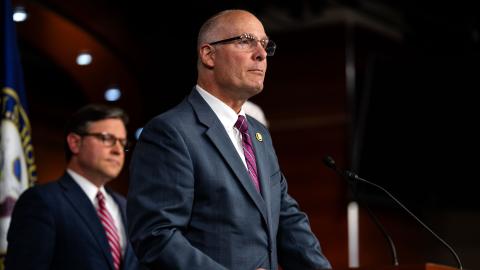Prior to 2016, Americans imposed pretty clear resume requirements on their presidents. Every man elected as president between 1789 and 2012 had either been a vice president, a governor, a senator, a cabinet secretary, or a commanding general—with one exception. That exception was the foremost spokesman on the foremost issue of the day, and even he, Abraham Lincoln, had been a congressman.
So how did Donald Trump, a man who has held none of the positions listed above, beat a former senator and cabinet secretary to win the presidency? In an election focused on character, Trump won on the issues.
The exit polling offers striking evidence of this. Those who viewed Trump favorably and Hillary Clinton unfavorably voted for him, of course, just as those who viewed Clinton favorably and Trump unfavorably voted for her. But among the 18 percent of voters who viewed neither candidate favorably, Trump beat Clinton by a whopping 20 points—49 percent to 29 percent (with the remainder either voting for a third-party candidate or not answering).
What’s more, among the 14 percent of voters who thought neither candidate was qualified, Trump won by 54 points (69 to 15 percent). Among the 5 percent who thought both were qualified, he won by 48 points (70 to 22 percent). Among the 14 percent who thought neither candidate had the right temperament, Trump won by 59 points (71 to 12 percent). Among the 6 percent who thought both did, he won by 58 points (77 to 19 percent).
In other words, when Americans didn’t view considerations of character or experience as decisive, they voted for Trump over Clinton by huge margins. They did so because four issues favored him—immigration, trade, the Supreme Court, and Obamacare—while no issues favored her.
Although the Republican establishment would rather not think about it, immigration was Trump’s central issue as he came out of nowhere to beat 16 challengers and win the Republican nomination. Those same establishment Republicans, like most Democrats, predicted that immigration would hurt Trump in the general election. It didn’t.
Believers in the “Blue Wall”—the mythical fortification that would allegedly protect Democratic candidates in the electoral vote—claimed that embracing open-borders immigration policies is the only way to win as demographics change (largely because of 40-plus years of open-borders immigration policies). This “Blue Wall” turned out to be about as formidable as the Maginot Line, and Trump breached it in Pennsylvania, Wisconsin, Iowa, and apparently Michigan.
Immigration is actually a big reason why. When exit polling asked voters what the biggest issue was in the election, national security was about a wash—as voters who emphasized “foreign policy” preferred Clinton, while those who emphasized “terrorism” favored Trump, and by similar margins. Likewise, the economy as a whole was about a wash. Among the 52 percent of voters who said the economy was the biggest issue, Clinton won by 10 points (52 to 42 percent), but when voters were asked who would better handle the economy, Trump won by 3 points (49 to 46 percent). Among the one-eighth of voters who said immigration was the most important issue, however, Trump won by a 2-to-1 margin (64 to 32 percent)—the equivalent of about 5 million votes. In the states where Trump breached the “Blue Wall,” his margins on immigration were even bigger.
Nor did Trump’s hawkishness on immigration remotely spell his doom, as many predicted, with non-white voters. Trump fared about equally well as Mitt Romney among white voters, as Romney won by 20 points (59 to 39 percent) and Trump won by 21 points (58 to 37 percent), while the share of white voters dropped from 72 percent in 2012 to 70 percent in 2016. Trump improved on Romney’s performance nationally because Trump did significantly better than Romney among black voters (losing by 80 points instead of Romney’s 87), Latino voters (losing by 36 points versus Romney’s 44), and Asian voters (losing by 36 points versus Romney’s 47). This roughly 8-point improvement in the margin among non-white voters is the main reason Trump beat Romney’s share of the popular vote.
Perhaps most interestingly, Trump did much better than Romney among Latino voters in the Southwest and Frontier West. In Arizona, Nevada, Colorado, and New Mexico, Trump swung the margin among Latino voters his way by between 15 and 19 points, in relation to Romney, in each state. For example, in Colorado, Romney lost Latino voters by 52 points (75 to 23 percent), while Trump lost them by 37 points (67 to 30 percent). In three of these four states (all but New Mexico), the percentage of voters who were Latino dropped from 2012 to 2016. Trump fared better than Romney in all of these states except for Arizona.
In Arizona, Latino voters nevertheless moved toward the GOP—as Romney’s 49-point loss among Latinos became a 30-point loss for Trump. Trump’s overall margin of victory in the Grand Canyon State (he still won by 4 points) was smaller than Romney’s because Romney fared better with white voters and college graduates. In other words, the Democrats’ improved performance in Arizona was not the result of a surge in Latino support—it came in spite of a surge in Latino support for the GOP nominee.
Beyond immigration, Trump benefitted from the issue of trade. Exit polling found that voters think international trade more likely takes away American jobs (42 percent) than creates them (38 percent). Trump enjoyed a 34-point margin of victory among those who distrust trade (65 to 31 percent), while Clinton enjoyed just a 24-point margin of victory among those who laud trade (59 to 35 percent).
Even more beneficially for Trump, the gap between those who think that trade saps jobs and those who think it sustains them was much bigger in the Great Lakes region. Voters viewed trade as bad, rather than good, by 19 points (53 to 34 percent) in Pennsylvania, 16 points (48 to 32 percent) in Ohio, 15 points (50 to 35 percent) in Wisconsin, and 19 points (50 to 31 percent) in Michigan.
Trump’s criticism of U.S. trade policies is presumably a large part of why he did so well with non-college graduates in all of these states. While Romney handily lost among non-college grads in all four places, Trump won among them by margins ranging from 4 points in Michigan (where non-college graduates really turned out to vote) to 16 points in Wisconsin.
The Supreme Court was a third issue favoring Trump. Among the 28 percent of voters who said that Supreme Court appointments were not very important, Clinton won by 12 points (52 to 40 percent). Among the 70 percent who said they were important, Trump won by 4 points (50 to 46 percent). Among the subset of that 70 percent who said the Court was the most important factor in their vote, Trump won by 15 points (56 to 41 percent). The more people cared about the Court, the more apt they were to vote for Trump.
A fourth and final issue that plainly favored Trump was Obamacare. The exit polling on this issue is not particularly helpful, as it didn’t ask people whether they approved or disapproved of Obamacare, or how much it affected their vote. Such polling nevertheless found that a large plurality of voters—47 percent—think Obama’s namesake “went too far,” and such voters backed Trump by 70 points (83 to 13 percent). Even beyond the exit polling, the issue undoubtedly helped Trump, as evidenced by Bill Clinton’s calling Obamacare “the craziest thing in the world.”
Indeed, this election would seem to be the third strike for the Democrats on Obamacare. When they passed it (without a single Republican vote), they held a 75-member majority in the House, a 20-member majority in the Senate, and the presidency. They have now lost control of all three entities. With the U.S.S. Obamacare now seemingly sinking, it will be interesting to see whether some Democrats start swimming for the life rafts and embrace the idea of repeal and replacement. That’s an idea that Trump particularly emphasized in the campaign’s waning days.
While Trump hasn’t gotten a lot of credit in the media for advancing policy ideas, he won the Republican nomination largely because the two issues that became the focus of the GOP primary—immigration and trade—were his. (What were any of the other Republican candidates’ signature issues?) He has now won the presidency largely because of four issues on which voters agreed with him and disagreed with Hillary Clinton: immigration, trade, the composition of the Court, and Obamacare.
Indeed, voters preferred Trump’s views on the issues so overwhelmingly to Clinton’s, or Obama’s, that they were willing to break with 227 years of precedent and trust the presidency to a man who hadn’t occupied any of the traditional stepping-stone political offices. This is really quite extraordinary.

















